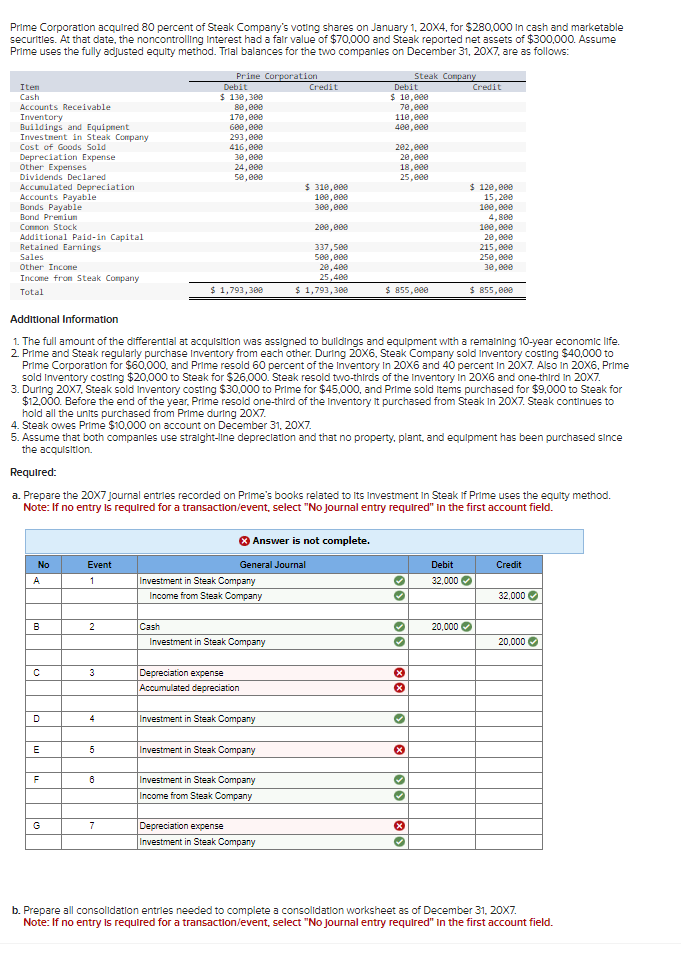Prime Corporation acquired 80 percent of Steak Company's voting shares on January 1, 20X4, for $280,000 in cash and marketable securities. At that date, the noncontrolling Interest had a fair value of $70,000 and Steak reported net assets of $300,000. Assume Prime uses the fully adjusted equity method. Trial balances for the two companies on December 31, 20X7, are as follows: Steak Company Iten Cash Accounts Receivable Inventory Buildings and Equipment Investment in Steak Company Cost of Goods Sold Depreciation Expense Other Expenses Dividends Declared Accumulated Depreciation Accounts Payable Bonds Payable Bond Premium Connon Stock Prime Corporation Debit $ 130,300 80,000 170,000 600,000 293,000 416,000 30,000 24,000 50,000 Credit $ 310,000 100,000 300,000 200 000 Debit $ 10,000 70,000 110,000 400,000 202,000 20,000 18,000 25,000 Credit $ 120,000 15,200 100,000 4,800 100 000
Prime Corporation acquired 80 percent of Steak Company's voting shares on January 1, 20X4, for $280,000 in cash and marketable securities. At that date, the noncontrolling Interest had a fair value of $70,000 and Steak reported net assets of $300,000. Assume Prime uses the fully adjusted equity method. Trial balances for the two companies on December 31, 20X7, are as follows: Steak Company Iten Cash Accounts Receivable Inventory Buildings and Equipment Investment in Steak Company Cost of Goods Sold Depreciation Expense Other Expenses Dividends Declared Accumulated Depreciation Accounts Payable Bonds Payable Bond Premium Connon Stock Prime Corporation Debit $ 130,300 80,000 170,000 600,000 293,000 416,000 30,000 24,000 50,000 Credit $ 310,000 100,000 300,000 200 000 Debit $ 10,000 70,000 110,000 400,000 202,000 20,000 18,000 25,000 Credit $ 120,000 15,200 100,000 4,800 100 000
Chapter20: Corporations: Distributions In Complete Liquidation And An Overview Of Reorganizations
Section: Chapter Questions
Problem 35P
Related questions
Question

Transcribed Image Text:Prime Corporation acquired 80 percent of Steak Company's voting shares on January 1, 20X4, for $280,000 in cash and marketable
securities. At that date, the noncontrolling Interest had a fair value of $70,000 and Steak reported net assets of $300,000. Assume
Prime uses the fully adjusted equity method. Trial balances for the two companies on December 31, 20X7, are as follows:
Steak Company
Iten
Cash
Accounts Receivable
Inventory
Buildings and Equipment
Investment in Steak Company
Cost of Goods Sold
Depreciation Expense
Other Expenses
Dividends Declared
Accumulated Depreciation
Accounts Payable
Bonds Payable
Bond Premium
Connon Stock
Additional Paid-in Capital
Retained Earnings
Sales
Other Income
Income from Steak Company
Total
No
A
B
C
D
E
LL
F
G
Event
1
Additional Information
1. The full amount of the differential at acquisition was assigned to buildings and equipment with a remaining 10-year economic life.
2. Prime and Steak regularly purchase Inventory from each other. During 20X6, Steak Company sold Inventory costing $40,000 to
Prime Corporation for $60,000, and Prime resold 60 percent of the Inventory In 20X6 and 40 percent In 20X7. Also in 20X6, Prime
sold Inventory costing $20,000 to Steak for $26,000. Steak resold two-thirds of the Inventory in 20X6 and one-third In 20x7.
3. During 20X7, Steak sold Inventory costing $30,000 to Prime for $45,000, and Prime sold Items purchased for $9,000 to Steak for
$12,000. Before the end of the year, Prime resold one-third of the Inventory it purchased from Steak in 20X7. Steak continues to
hold all the units purchased from Prime during 20X7.
4. Steak owes Prime $10,000 on account on December 31, 20X7.
2
5. Assume that both companies use straight-line depreciation and that no property, plant, and equipment has be purchased since
the acquisition.
Required:
3
a. Prepare the 20X7 journal entries recorded on Prime's books related to its Investment in Steak if Prime uses the equity method.
Note: If no entry is required for a transaction/event, select "No Journal entry required" in the first account field.
5
Prime Corporation
6
Debit
$ 130,300
80,000
170,000
7
600,000
293,000
416,000
30,000
24,000
50,000
$ 1,793,300
Cash
Investment in Steak Company
Income from Steak Company
Depreciation expense
Accumulated depreciation
Answer is not complete.
General Journal
Investment in Steak Company
Credit
$ 310,000
100,000
300,000
200,000
337,500
500,000
20,400
25,400
$ 1,793,300
Investment in Steak Company
Investment in Steak Company
Investment in Steak Company
Income from Steak Company
Debit
$ 10,000
70,000
110,000
400,000
Depreciation expense
Investment in Steak Company
202,000
20,000
18,000
25,000
$ 855,000
33
X
X
3
X
››
3*
Credit
$120,000
15,200
100,000
X
4,888
100,000
20,000
215,000
250,000
30,000
$ 855,000
20,000
Debit
32,000 ✓
Credit
32,000✔
20,000✔
b. Prepare all consolidation entries needed to complete a consolidation worksheet as of December 31, 20X7.
Note: If no entry is required for a transaction/event, select "No Journal entry required" in the first account field.
Expert Solution
This question has been solved!
Explore an expertly crafted, step-by-step solution for a thorough understanding of key concepts.
Step by step
Solved in 4 steps with 8 images

Knowledge Booster
Learn more about
Need a deep-dive on the concept behind this application? Look no further. Learn more about this topic, accounting and related others by exploring similar questions and additional content below.Recommended textbooks for you







Intermediate Accounting: Reporting And Analysis
Accounting
ISBN:
9781337788281
Author:
James M. Wahlen, Jefferson P. Jones, Donald Pagach
Publisher:
Cengage Learning